
FIGURE 24–22 From Wild Grass to Staple Crop The selective breeding of a wild grass called teosinte about 8000 years ago led to the development of maize and modern corn.
You may not have thought of it this way, but the food we eat from most crop plants is taken from their seeds. For nutrition, most of humanity worldwide depends on the endosperm of only a few carefully cultivated species of grass. The pattern in the United States follows this trend. Roughly 80 percent of all U.S. cropland is used to grow just four crops: wheat, corn, soybeans, and hay. Of these crops, three—wheat, corn, and hay—are derived from grasses.
New Plants The discovery and introduction of new crop plants has frequently changed human history. Before they were discovered in the Americas, many important crops—including corn, peanuts, and potatoes—were unknown in Europe. The introduction of these plants changed European agriculture rapidly. We think of boiled potatoes, for example, as a traditional staple of German and Irish cooking, but 400 years ago, potatoes were new items in the diets of Europeans.
The efficiency of agriculture has been improved through the selective breeding of crop plants and improvements in farming techniques. Recall from Chapter 15 that selective breeding is a method for improving a species by allowing only organisms with certain traits to produce the next generation. The corn grown by Native Americans, for example, was developed more than 8000 years ago from teosinte, a wild grass found in Mexico. Further selective breeding has produced modern-day corn. The changes caused by selective breeding can be very dramatic, as shown in Figure 24–22.
In more recent times, other familiar crops have been the product of selective breeding. Sugar beets, the source of most refined sugar from the United States, were produced from the ordinary garden beet using selective breeding. Plants as different as cabbage, broccoli, and Brussels sprouts have been developed from a single species of wild mustard.
Table of Contents
- Formulas and Equations
- Applying Formulas and Equations
- Mean, Median, and Mode
- Estimation
- Using Measurements in Calculations
- Effects of Measurement Errors
- Accuracy
- Precision
- Comparing Accuracy and Precision
- Significant Figures
- Calculating With Significant Figures
- Scientific Notation
- Calculating With Scientific Notation
- Dimensional Analysis
- Applying Dimensional Analysis




